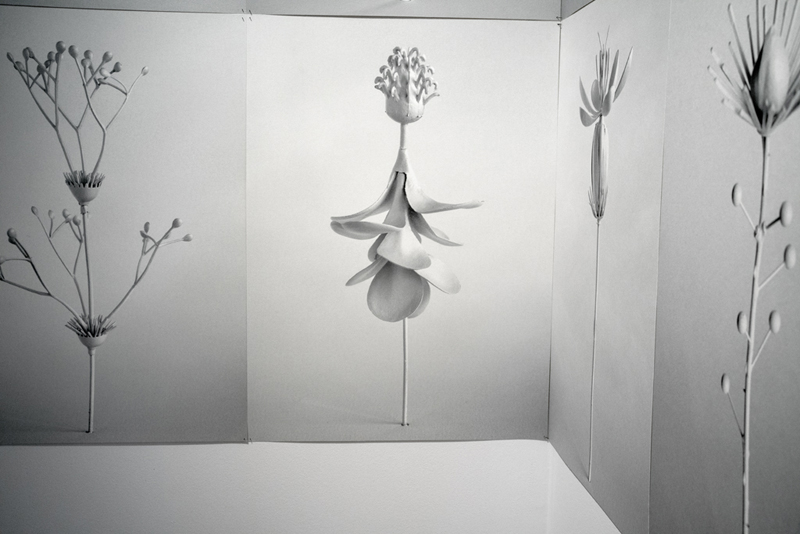INTRA exhibition, Artistic practice as a model of experience
Suñol Foundation from 22/04/2022 to 07/05/2022.
The symbolic idea of a prototype, understood as an expanded model or preliminary and always provisional model of a later active production, is the conceptual nexus that articulates the diversity of projects and production processes that are presented in the exhibition.
Artists: Eugènia Agustí, Lali Barrière, Joaquim Cantalozella, Mercè Casanovas, Lúa Coderch, Paco Chanivet, Alejandra López, Beatriz Regueira, Javier Lozano, Esther Moñivas, Marta Negre, Òscar Padilla, Cristina Pastó, Eloi Puig, Albert Valera, Antonia Vilà, Alicia Vela and Angels Viladomiu.
Suñol Foundation.
Mejía Lequerica 14, 08028 Barcelona
+34 934 961 032
info@fundaciosunol.org
Hours: Wednesday to Friday, 11 a.m. to 2 p.m. and 4 p.m. to 7 p.m.
One Saturday a month Free entrance
Mercè Casanovas
Repensant a Penone (Rethinking Penone)
In the series Essere Fiume (1981), Giuseppe Penone takes a naturally-formed stone from a river bed, duplicates it and assigns it to belonging to a divinely-created order. Then, taking a second stone, the artist painstakingly reproduces the shape of the first, and changes its status: as it moves from the natural world into the world of culture.
This subtlety of imperfect resemblance, the fictional aspect of mimicry that entails a duplicity with respect to the natural process has led me to rethink Penone’s work and extrapolate it to the world of 3D printing.
The act of scanning a stone and printing it in three dimensions perfectly reproduces every fragment and every detail of the original object, however its nature is different. The material used to for the printing process is a biodegradable plastic (PLA) that captures the shape and texture of the original, nonetheless, the weight, feel and the language used are all different.
In Essere Fiume, the sculptor becomes the water of a river that slowly shapes, hones and polishes the stone. Now, in this new process, it is the printer that builds and reproduces the original stone, layer by layer, its actions being based on the information transmitted by the computer. The water will wear away the PLA, just as, over time, the river polishes and erodes the stone on the river bed.
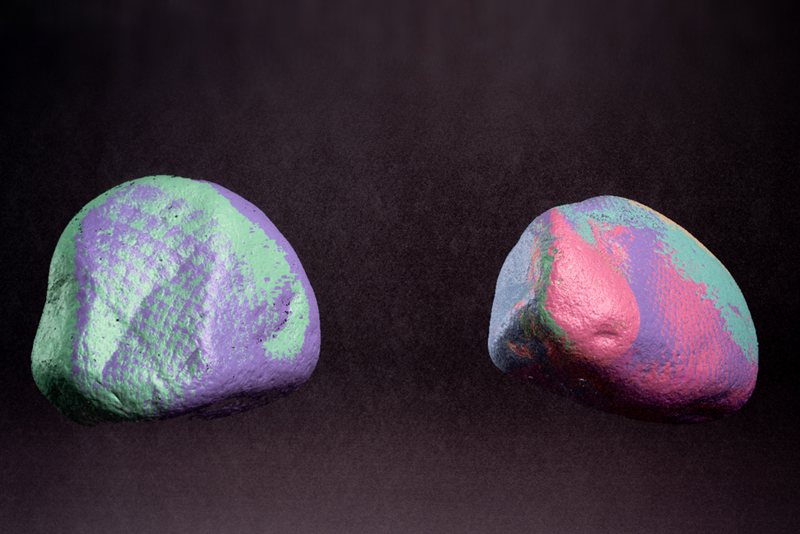
Eloi Puig
Tilottama-Kotekan Alignment
The Tilottama-Kotekan Alignment (2018-2019) is based on the comparison of two given images. On the one hand, the image of the nymph Tilottama, the main character in the Hindu legend of the Sunda and Upasunda asuras, and the figure responsible for causing their mutual destruction, due to their love for her. Even the gods Shiva and Indra are described as being in love with Tilottama. The drawing itself is the work of the Indian painter Raya Ravi Varma, and is a clear fusion of indigenous traditions with the techniques of European academic art. On the other hand we have a photograph of a gangsa kantilan, from a set of Balinese instruments called the gamelan. In the summer of 2018, Víctor Ojeda, a member of the Gamelan group Penempaan Guntur1, wrote a score for these instruments that puts music to the legend.
The comparison between the two images has been made by Sigmament, an image alignment software created by Marc Padró. It is based a sequence alignment method that uses the Needleman-Wunsch algorithm.
The Tilottama-Kotekan Alignment is presented in a dialogue with Pinot Gallizio's work Industrial Painting, from 1985. As an artist and a member of the Situationist Movement, Gallizio sought to subvert the capitalist commodification of everyday life. This work sought to adapt mechanized manufacturing techniques to challenge established models for art production and distribution. The work is a painted canvas, some 174 metres in length, which has been rolled up and of which only about ten metres are visible. It was made using a low-tech, pseudo-painting machine, to simulate industrial production, while maintaining the entity of a single piece. Gallizio, would then cut it into sections as objects to be sold.
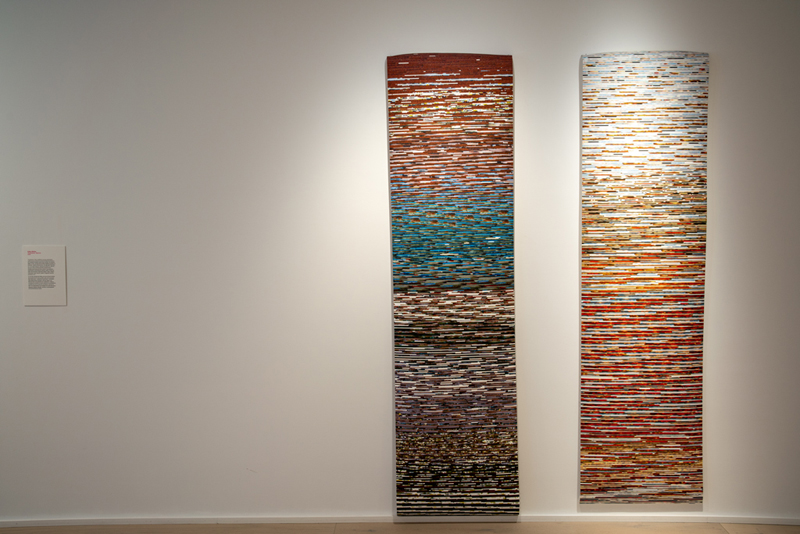
Eugènia Agustí, Lali Barrière
3.000 passos fins al blau gel (3,000 Steps to Ice Blue)
This piece is a minimalist Generative animation that has been created using a 3D Processing program, and which is inspired by Albrecht Dürer's polyhedron. The animation shows a polyhedron in continuous rotation, however the edges and the contours of the faces are not shown. As such, the appearance perceived by the viewer is of a flat figure; a polygon that varies over time. The animated display allows us to guess the three-dimensional nature of the complete object. This visual ambiguity is accentuated by the use of colour. The background colour has been created from the figure’s colour by adding a small amount of white. The polyhedron is a truncated rhombohedrum with two triangular faces and six pentagonal faces, and which rotates on three axes. Its flat representation is an orthogonal projection. In the creation of the animated work, the rotation matrices were calculated, rather than using the 3D Processing tools. The goal was to control the orthogonal projection and work with the coordinates of points in space, or on the surface of a flat surface. The animation parameters comprised the polyhedron's truncation angle and, the rotation speeds on each axis, the polyhedron’s size, and its colour. All the parameters may change arbitrarily, adding greater significance to colour changes. Transitions happen at random times, although always at a slow pace.
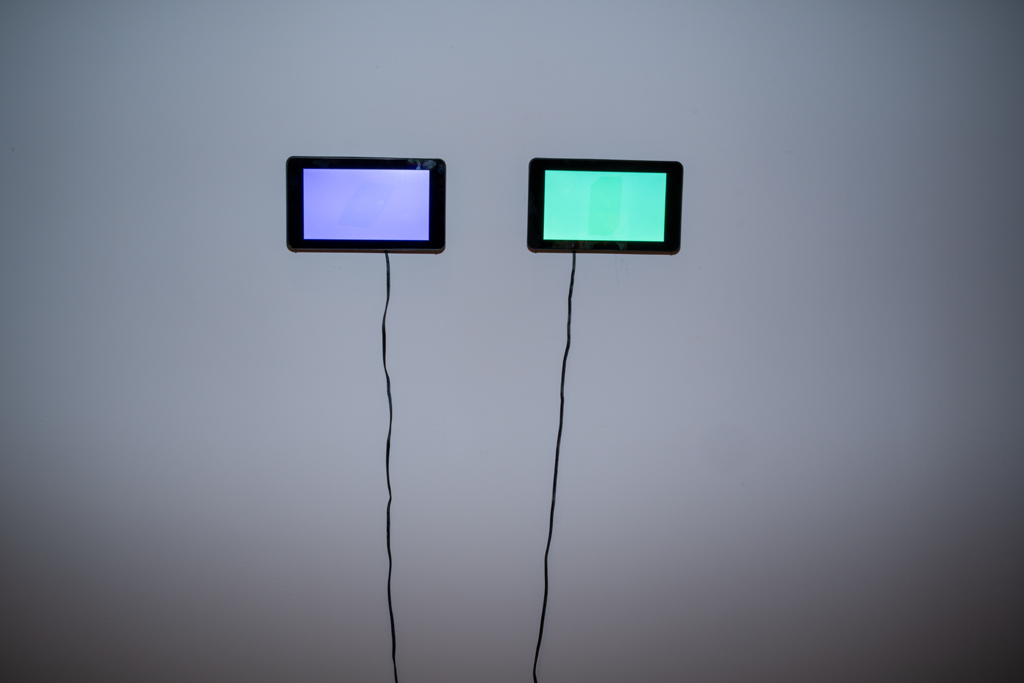
Joaquim Canatalozella
Aurea de bondat (Aura of Kindness)
I have presented the prototype of a luminous halo, which I have built in three dimensions, first using a malleable material, before reproducing it using digital printing techniques. Both processes confront the constitutive logic of what is being represented: making the light emanations from a body into a physical form. Due to its nature, light does not have a specific shape, however, it has been represented in a broad variety of manners. These are, in themselves, visual essays filled with illusions, although they possess a remarkable ability to form the basis of stories. My project seeks to continue the process of a formal speculation that concerns capturing and representing the incomprehensible.
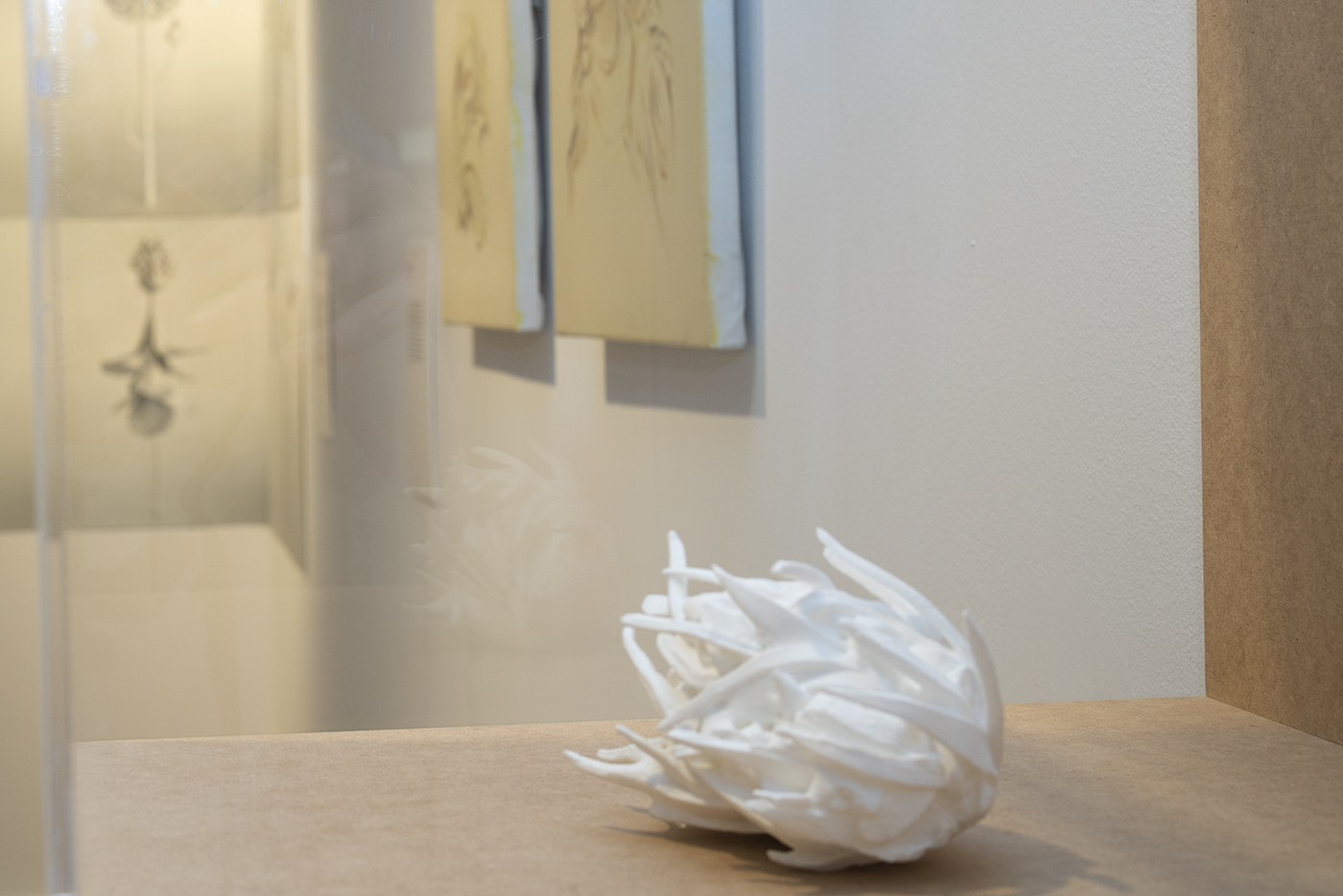
Lúa Coderch
No yo (Not I)
No yo (2018) is a video work that explores the different problems related to the voice as a physical phenomenon in speech and discourse. It is a series of six episodes that each correspond to a different character, all of them seemingly narrated by a female mouth, which out of context, and appears in the middle of a solid block of white flesh/makeup/nude skin colour. The female mouth serves as visual support for a voice, but the sounds of the voice (the words spoken) do not emanate from this source. The mouth (Ikram Bouloum) appears to say the words, but neither the voice, nor the words (Lúa Coderch) belong to it. The mismatch or discrepancy between the two speakers is resolved (and not always) by violating the image, giving the mouth a certain mechanical appearance. No yo takes as its title and starting point a play and film by Samuel Beckett, from the early 1970s (or at least the memory of having seen it two or three years ago). In Beckett's original piece, a woman's mouth appears out of context in the middle of a solid black block, and it recalls, in an interrupted narrative, several episodes that it denies having happened to the speaker.
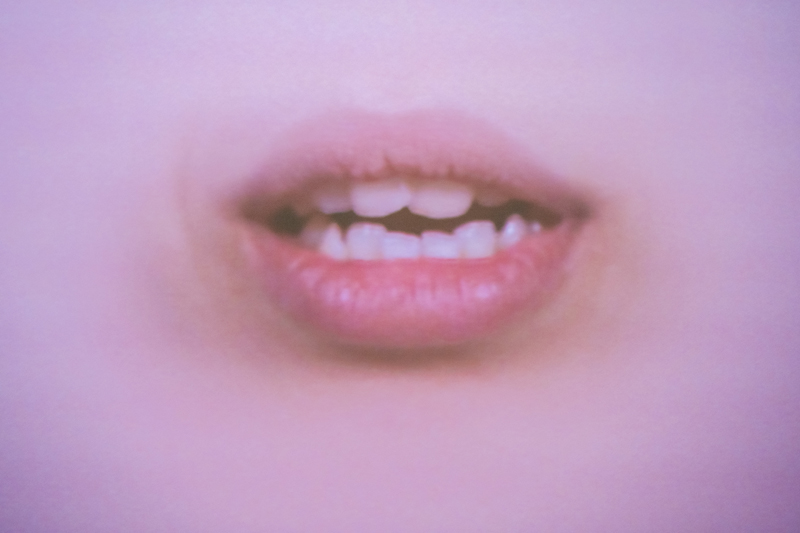
Paco Chanivet, Alejandra Gabrielidis
Etern retorn (Eternal Return)
Etern retorn (2018) is a collaborative artwork made by Paco Chanivet and Alejandra López Gabrielidis for Barcelona Production 2018. It was exhibited between 26 April 26 and 1 July 2018 at the La Capella venue. The piece comprises a monkey’s hand emerging from a pile of cashews, it is holding a mobile phone. The food product itself is used to counteract obsessive-narcissistic traits and desensitization, and is a natural anti-depressant, a condition that in itself goes hand in hand with the excessively-solipsistic psychic dimension of the ego. The mobile screen shows a video that produces short sentences, which appear like the credits of a film, one whose end and beginning we already know, with the aesthetics of stock Hollywood mass-produced imagery. The sentences appear and disappear in a twinkling format and begin with the quantified soul, digital dopamine, automated subjectivity, and the market around it, and the display ends with screen surplus and serotonin deficit. The final announcement reads: "The revenge of flesh is coming."
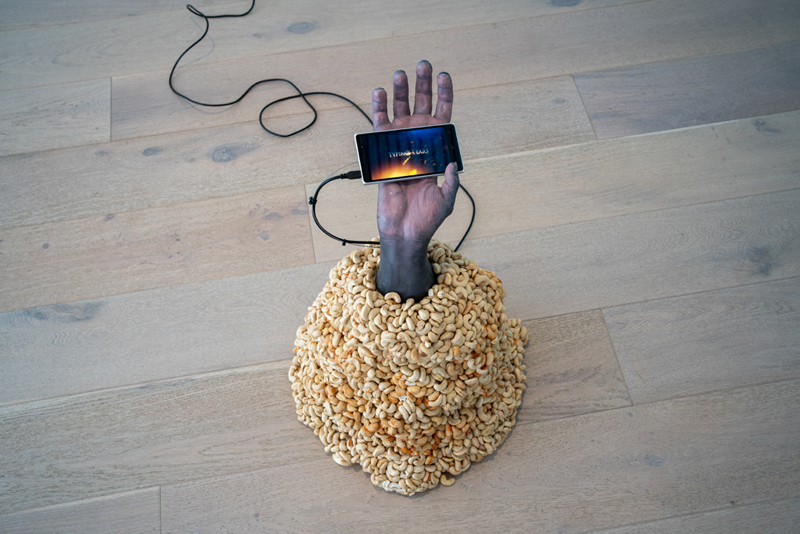
Beatriz Regueira Pons
_fantásticas_<3/
_fantàsticas_<3 (2019) is a video whose title alludes to the double meaning of the word, i.e. that of being illusory and extraordinary. cap_1 love_ patriarchal_screens_projection is the first of four chapters, still under construction, and which address the relationships between "politics_body_language_I_love". It is a video that combines the tales of love that exist between mother and daughter, and the cognitive and emotional mechanisms that operate in the love experience and its link with the techno-patriarchal system.
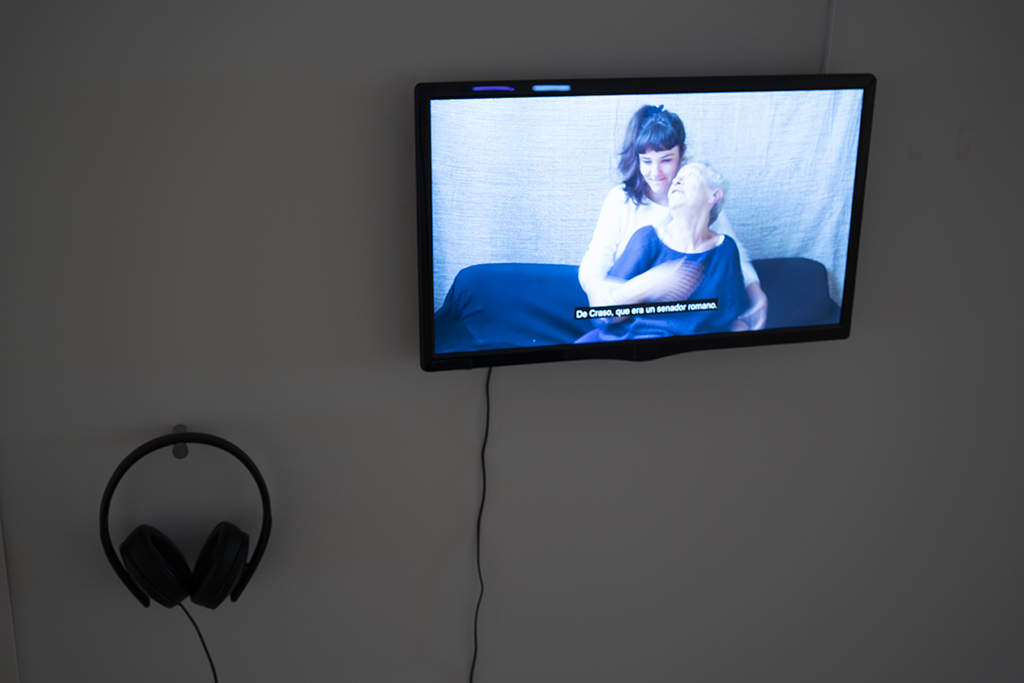
Javier Lozano
Santuari profà (Profane Sanctuary)
This is the architectural model of an evidently formal character that is inspired by Deyan Sudjic's theories on architecture and power. The work seeks to show how architecture has always been dependent on the patronage of factual powers, speculative investment, or religion. It outlines the lack of ethics and morality in monumental projects, the megalomaniacal delusion of the powerful, and of architects with respect to public space or the city as a democratic artefact.
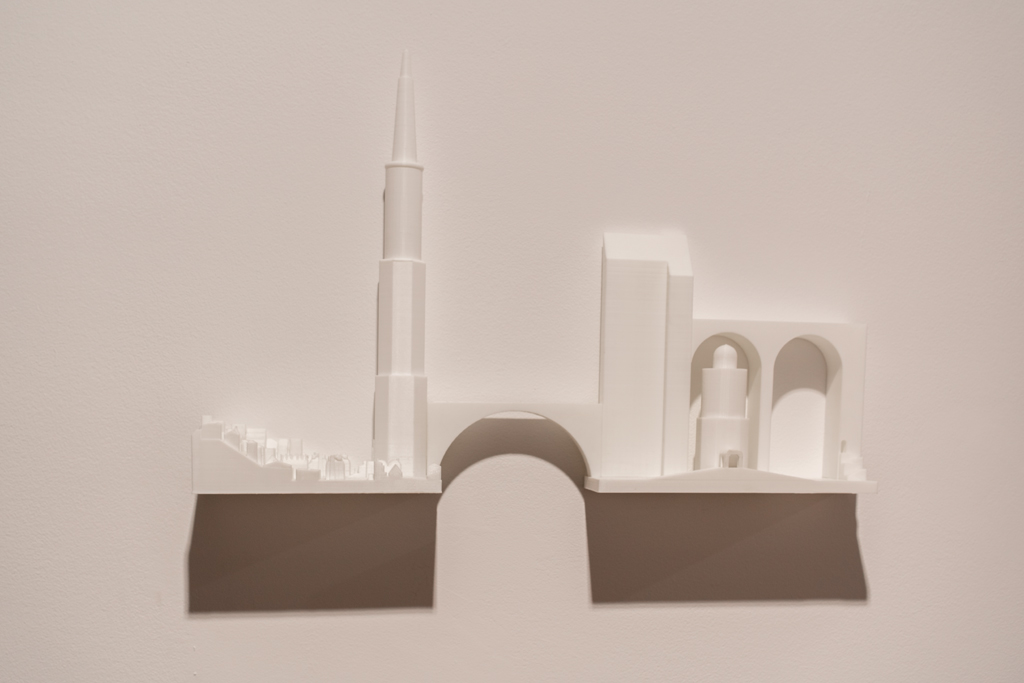
Esther Moñivas
Transferència. Teixit viu (Transference. Living Tissue)
Transfer Teixit viu (2018) is a performative and audio-visual work that demonstrates the primacy given to processes and emergent properties over results and isolated elements. In it, a physical net of wool demonstrates the position and intensity – the number of interventions - of each human agent within a certain temporal and spatial margin within a system of relationships, as well as this individual’s connection with other physical-symbolic elements that are part of the discourse and which also experience transformations (plants, stones, pieces of paper with annotations, digital devices, cables, projected images, aluminium foil, plastics, printed diagrams, sculptures, etc.).
In an advanced phase of the dialogue, the flows of tissue that derive from the movement of hands when speaking, and the changes in the interlocutors’ positions, who become—transmit each minor tension and fluctuation, and this in turn extends the transfer of knowledge into a physical dimension. The conceptual objective is to re-locate artistic research into an expanded perspective within the knowledge society, while assuming the value and problems that involve its relational, affective and sensory dimensions and, therefore, those that are not exclusively wielded and weaponised by capital.
This piece was part of the Art-Science-Society Transfers working board, which was led by Esther Moñivas Mayor, Alejandra López Gabrielidis and Beatriz Regueira, at the Shared Prototypes Symposium. Collaborative Artistic Experiences, which was held in November 2018 at the Faculty of Fine Arts of the University of Barcelona. At the event, Neomaterialist methodological prototypes were put into operation within the ACTSE (art-science-technology-society-ecology) framework, using Donna Haraway’s concepts on the cyborg (1991) as a basis, as well as those concepts on diffraction and intra-action, as outlined by Karen Barad (2007).
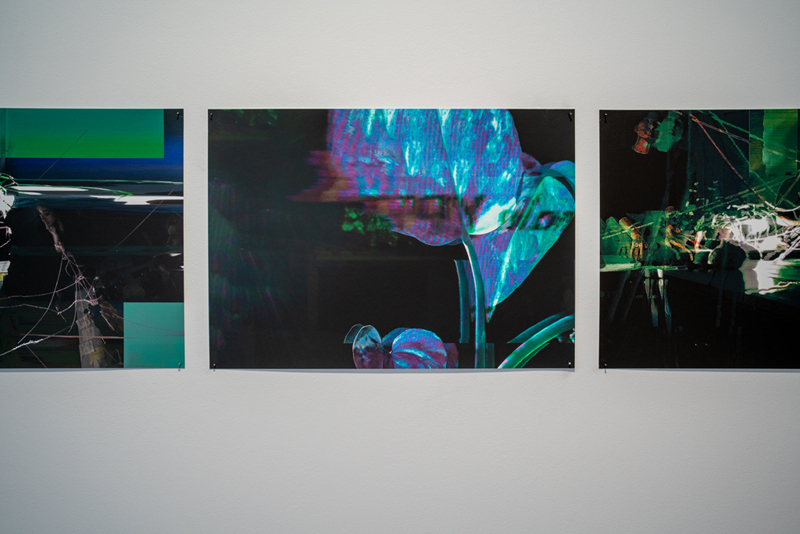
Marta Negre
Treball (Work)
The work I am presenting is the continuation of the Rock, Paper, Scissors project. It is a 3D sculptural piece that reproduces (on a small scale) the pick that my father and grandfather used to work with. The latter, as I explain in the article that appears in this publication, had been a prisoner in the workers' battalions, who were forced to rebuild railway lines after the Spanish Civil War by the Fascist dictatorship. The pick therefore symbolizes not only work, but also punishment and submission. Making it into a reproducible object facilitates debate with respect to my own memory, which is both personal and simultaneously shared by thousands of people. The small size of the work recalls pieces from board games, or souvenirs, or the exhibits in a collection, although in this case the original item of reference does not come from a work of great feats, but from everyday tools that are full of experiences.
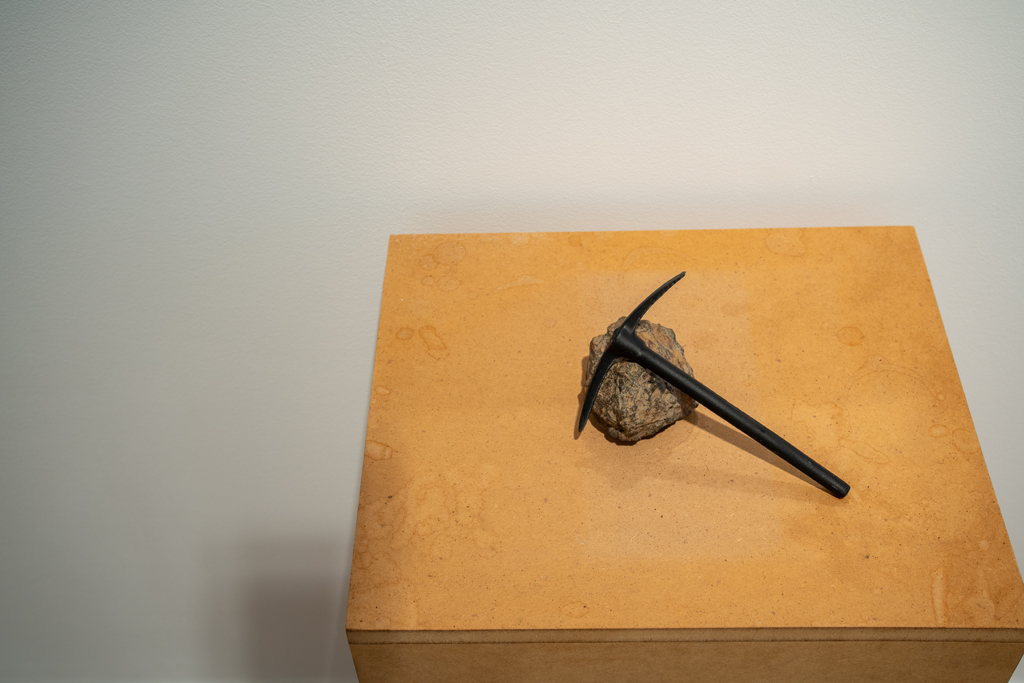
Òscar Padilla
Loading
My work focuses on the contemporary perception of time: this is a concept that has gone from a production system with its own predictable and patterned rhythms, to a system based on the transmission of data, the temporality of which is diffuse. This situation generates paradoxes and contradictions in everyday life, as it seems to make time pass at different rates in the same space. Pictorial actions, videos and three-dimensional objects, which enter into dialogue with the constructive elements of painting, go to make up a set of pieces that are characterized by the repetitive representation of certain materials, all of which have been assembled with the intention of awakening a specific imaginary world: fragments of stones with a high percentage of silicon, Prussian blue and marking paint.
In this context, flint becomes a fundamental element of this conceptual universe; its material qualities make it possible to unite two far-distant points in the history of technology: the tools of prehistory and the computing devices of the 21st century.
The work I have presented here stresses the more materialistic aspects of my current labours, and it presents these paradoxes and different rhythms in a suspended time. I have sought to slow down, or even stop, something that is practically impossible to hold back, given that we are constantly called to action in a call to "urgency", as Boris Groys notes. In contrast to what occurred in previous decades, in which knowledge, work and leisure were all separated by different temporal divisions, we are now forced to act, constantly living through overlapping times and rhythms.
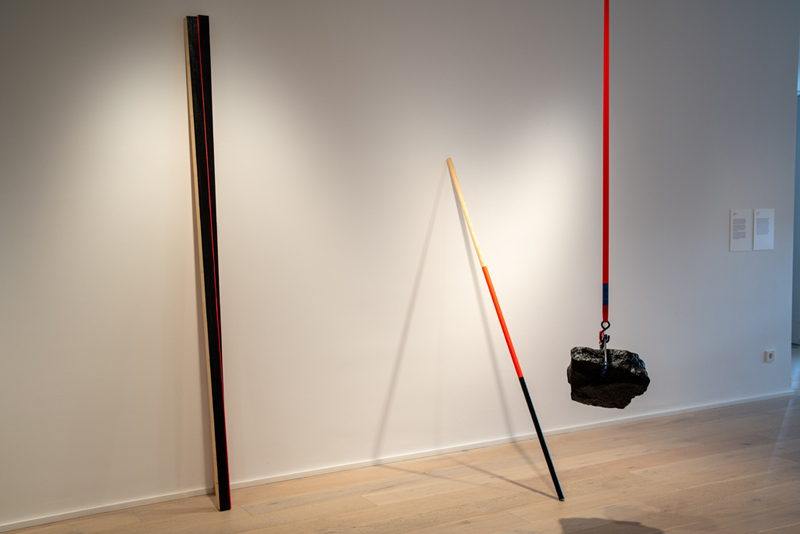
Cristina Pastó
Apoteci
This work, Apoteci (2019) has arisen from the continued dialogue between art, science and technology that I have been drawing on in my most-recent works. I have used a wide variety of media, such as meticulously-drawn botanical-like works, die-cutting processes and overlapping sheets of paper or, on this occasion, 3D printing.
In this project I tried to approach the behaviour and characteristics of a specific biological structure: that of lichens, with their symbiotic nature. These plants are able to store water thanks to one of their components, namely algae. I also considered the concept of layers, which is something intrinsic to 3D technology.
In order to start off with this initial idea, it was important to use a material that behaved organically and that gave meaning to my initial proposal. I tried using a translucent material, a mixture of ingredients from different algae and tubers that had high water-absorbent properties. The substance is gelatinous and moist to the touch, and it retains its characteristics for some 24 to 48 hours after being printed. However it later changes, depending on the conditions in its local environment. The model, once exposed to the air, gradually loses its qualities, it changes its appearance until it dries completely and its size is reduced until it is a mere tiny sample of what it once was.
What is really surprising, however, is that this same print, when rehydrated, is able to recover its original shape and retain all its original details and measurements. I am fascinated by its elasticity and resilience, which is one that is usually associated with living organisms. It is as if the printed piece encloses a memory that is capable of activating the opening of the apothecia of a lichen between the overlapping layers of material.
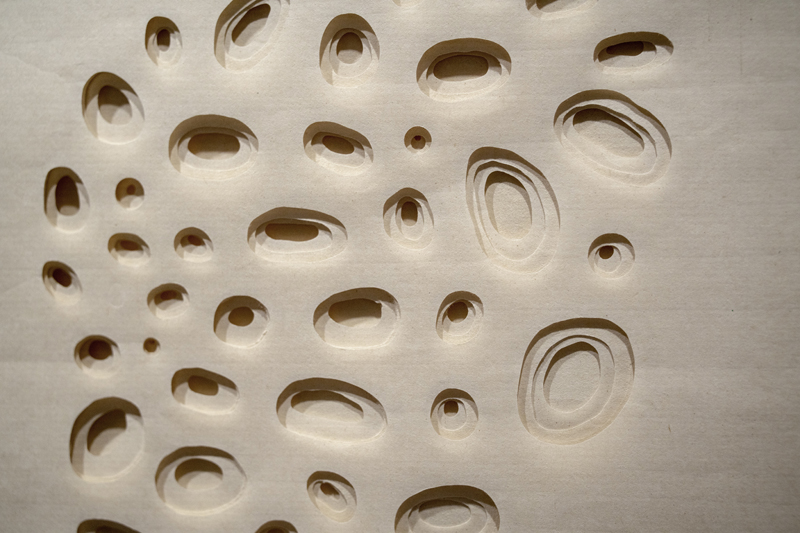
Albert Valera
30/28-26
When you walk through the streets of the city, close to the facades, you can see "the face of architecture", where the buildings poke their heads out into the public street; you seem to sense some of the character, both of the city’s inhabitants and its builders, you perceive a way of life and a historical era.
It is in this journey between architectures and people, with a gaze that seeks to reject the whole, and focus on the fragmented, where we discover new formal relationships that exist between the facades of the buildings and where the limit is both border and nexus.
30/28-26 (2018) seeks to signal a precise line, one defined by the meeting of two adjacent facades. It is a sign of a space that does not reach a single place and invites the viewer to confront a line in the middle of two places.
30/28-26 points to a precise, real point, a division that does not reveal its interior - as a portal does - but only points to it, this is a limitation like the line, where one place ends and another begins.
The work comprises a line marked in blue on a concrete wall, in the same fashion as used by builders when marking surfaces. This line is flanked by ceramic tiles, which indicate the numbering of two adjacent buildings and it faithfully reproduces to scale—using capture and 3D printing techniques—where the mouldings of the plinths of two buildings meet at this point.
The utilization and ownership of the available space have established a limit, a line between the different constructions. This border, which internally takes the form of a surface, manifests itself in the public space, on the street, as a line where the buildings both separate and connect at the same time. This is a line that gives continuity to the architecture and that separates the people who live on either side of it.
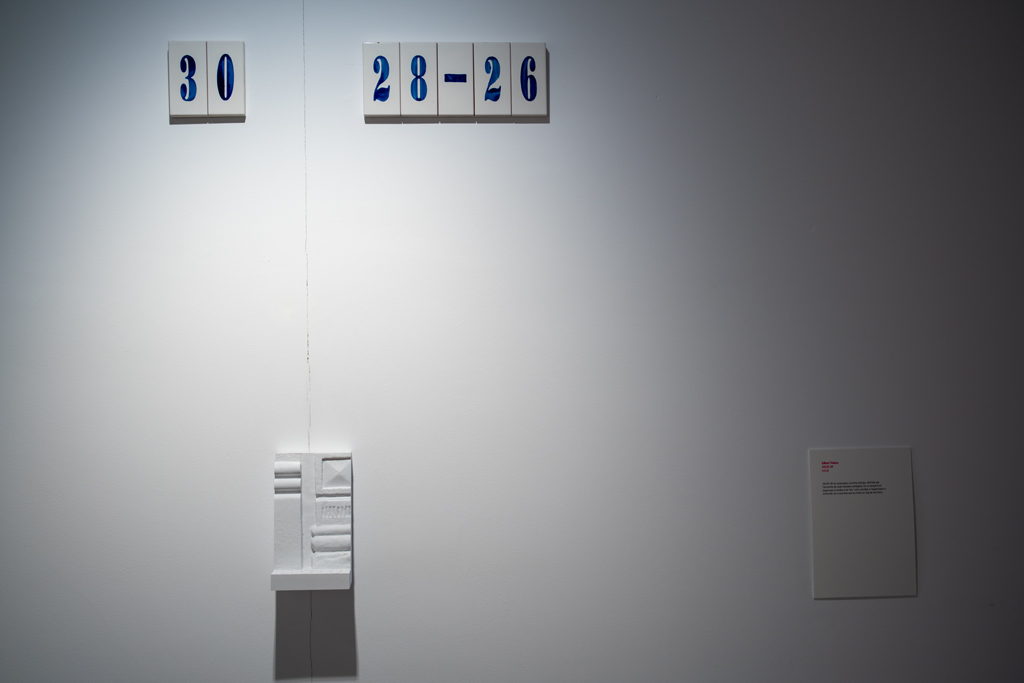
Alicia Vela, Antònia Vilà
Ficcions neuronals (Neuronal Fictions)
Layers of the brain. Neural fictions that respond to interpretations of atrophies and obstacles that occur in the brain and that constitute the stress maps of dementias. The brain understood as a space filled with stars, a place where star cells are suffocated by a siege of axons and astrocytes.
Neuronal Fictions I. Drawing with coloured pencils on paper 100 gr/m2, 21 × 29.7 cm, 2019.
Neuronal Fictions II. Drawing with coloured pencils on paper 100 gr/m2, 21 × 29.7 cm, 2019.
Neuronal Fictions III. Graphite, coloured pencil, wax and text on paper 100 gr/m2, 21 × 29.7 cm, 2019.
Neuronal Fictions IV. Pencil on paper 100 gr/m2, 21 × 29.7 cm, 2019.
Neuronal Fictions V. Digital print and pen text on paper 100 gr/m2, 21 × 29.7 cm, 2019.
Neuronal Fictions VI. Pen drawing on paper 100 gr/m2, 21 × 29.7 cm, 2019.
Neuronal Fictions VII. Pencil on paper 100 gr/m2, 21 × 29.7 cm, 2019.
Set of Fictions. Coloured pencil, graphite and pen on paper 100 gr/m2, variable dimensions, 2019

Àngels Viladomiu
Flor tipus/Flos generis (Flower Types/Flowers Generics)
The series of botanical models present here is the result of experimental artistic work performed using 3D technology around the idea of the Urpflanze (a primordial plant), which was described by Goethe in his well-known essay The Metamorphosis of Plants.
Flower type is a generative design of a common denominator flower. It starts from an undetermined number of formal patterns of flowering species that have been entered as blocks (leaves, stems, pistils, stamens, petals, etc.) in the library of a parametric digital modelling program. This software is then used to combine the 3D blocks of all the flowers we create, using fixed modular parameters in combination with an algorithm. This allows us to generate a new species that is at one and the same time, part of all the introduced species.
The utopian premise that this work is based on is that of how to obtain the Urpflanze, and it leads us to consider the fusion of all the plants on the planet into one. However, in order to undertake this monumental operation, one needs to deconstruct each and every plant in an attempt at "metaphorical de-hybridization", if it can be considered as such.
We are still in the early stages of this experiment and, regardless of its success or failure, the result is for now both confusing and interesting. It is complex, given that it deconstructs, de-localises and alters the constituent parts of plants, however, we will, in all events continue to insist on creating infinite probabilities from botanical models.
